ISSN ONLINE(2319-8753)PRINT(2347-6710)
ISSN ONLINE(2319-8753)PRINT(2347-6710)
P.L. Srinivasamurthy1, B.N.Sarada2, Karthik.B.S3, Shamanth.S.Holla3
|
| Related article at Pubmed, Scholar Google |
Visit for more related articles at International Journal of Innovative Research in Science, Engineering and Technology
Aluminum alloy 7075 has been widely used in aircraft structural application for many years. It is, however, prone to both stress corrosion cracking (SCC) and exfoliation (intergranular) corrosion. Over-aging has been used to resolve these problems. However, a strength penalty of around 10% is reported by researchers. Therefore, a process known as retrogression and reaging (RRA) treatment, which is capable of restoring peak strength while retaining resistance to SCC is suggested. The retrogression treatment produces rapid initial coarsening of the grain boundary particles and results in an increase in the volume per unit grain boundary area. This project is set up to study the influence of retrogression and reaging (RRA) heat treatment on the corrosion properties and of the aluminum alloy. The retrogression temperature is the main property controlling factor.
Keywords |
| AL-7075 alloy, retrogression and reaging, salt spray corrosion test, microstructure. |
I. INTRODUCTION |
| Al-7075 is one of the most widely used alloys in the 7000 series. This standard structural alloy is one of the most versatile of heat treatable alloys, popular for medium to high strength requirements and has good toughness characteristics. Alloy 7075 has excellent corrosion resistance to atmospheric conditions and also to sea water. This alloy also offers good finishing characteristics and responds well to anodizing, wherever cosmetic appearance is critical. Alloy 7075 is easily welded and joined by various commercial methods, since7075 is a heat treatable alloy. 7000 series alloys such as 7075 are often used in transport applications, including marine, automotive and aviation, due to their high strength-to-density ratio. Their strength and light weight is also desirable in other fields. Rock climbing equipment, bicycle components, and hang glider airframes are commonly made from 7075 aluminum alloy. One interesting use for 7075 is in the manufacture of M16 rifles for the American military. It is also commonly used in shafts for lacrosse sticks, camping knife and fork sets. Desert Tactical Arms and French armament company PGM use it for their precision rifles. Due to its strength, high density, thermal properties and its ability to be highly polished, 7075 is widely used in mold tool manufacture. |
| Retrogression and Reaging Heat Treatment: This heat treatment is accomplished in three major stages: Solutionization and age hardening, Retrogression, Reaging. |
| Solutionization and aging is a type of heat treatment used in metallurgy to strengthen metal alloys. It is also called precipitation hardening, as it strengthens the metal by creating solid impurities or precipitates. Its name comes from the point in the hardening process in which the metal is aged, either by heating it for an extended period of time or keeping it stored at a lower temperature for an extended period of time before use so that the precipitates can be formed. Examples of precipitation hardening alloys include 2000 series, 6000 series, and 7000 series aluminum alloy. |
| Retrogression: Due to aging, a strength penalty of around 10% to 20% occurs. To compensate this, retrogression is done. Retrogression consists of two stages. Firstly, the partial dissolution of the hardening precipitates that result in a decrease in hardness/yield strength which is regained in subsequent reaging. Secondly, for long time retrogression, the coarsening of precipitates takes place which results in continuous decrease in hardness/strength. |
| Reaging: It is a process of repeated aging which significantly improves the strength of the alloy. |
| Corrosion: Corrosion is the chemical reaction of a metal, with its environment, which leads to the deterioration of the properties of metals, aluminum in this case. The types of corrosion taking place in Al-7075 are Intergranular corrosion, Exfoliation corrosion, and Stress corrosion cracking (SCC), etc. The corrosion test is carried out using the Salt spray corrosion test machine in this case. |
II METHODOLOGY |
| Material selected: Aluminum 7075 alloy (Cu 1.49%, Mg 2.13%, Si .076%, Fe 0.22%, Mn 0.022, Cr 0.21%, Zn 5.18%, Ti .054%) |
| A. Heat treatment procedure: |
| Aluminum 7075 alloy castings produced by sand casting method are taken for the present study. They are heat treated (Plate2.1) by solutionization and aging. The specimens aresolutionized at 475˚C and aged at130˚C for different time intervals like 16hrs, 20hrs, 24hrs and water quenched. To improve SCC property, they are again retrograded and reaged as given below. |
| In retrogression treatment, the specimen which are peak aged are heated at three retrogression temperatures, i.e., 220, 260, 280˚C respectively, and maintained at this temperature for retrogression time intervals of 5 and 10 minutes. Later the specimens arereaged at 130˚C for 24 hours. |
| After heat treatment, micro structure and corrosion resistance are analyzed |
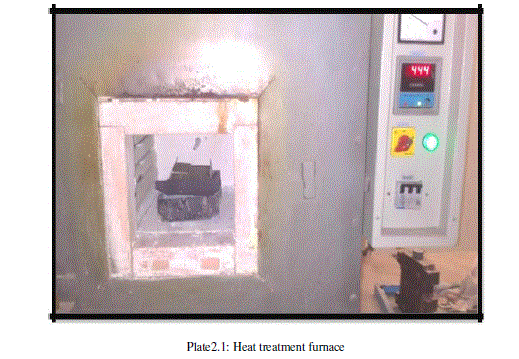 |
| B. Micro structural analysis |
| Metallographic specimens are prepared as per the ASTM E340 & ASTM E407 standards. A section perpendicular to the surface is chosen for interpretation of the material. This reveals all the information about phases that are present and their distribution, etc. |
| Abrasive papers of grit sizes 180, 400, 600, 1000 and polishing wheel are used to grind and polish the specimen respectively. After getting mirror finish, the specimen are etched with 90ml water, 4ml of HF, 4ml H2SO4 and 2g CrO3solution and observed under optical microscope (Plate2. 2) at 100 X and 200 X. |
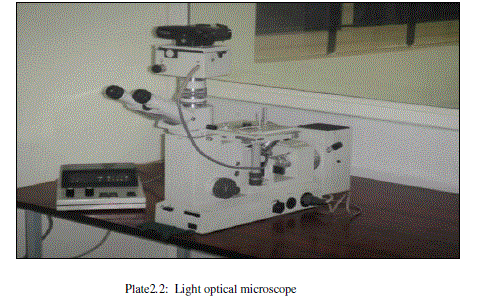 |
| C. Corrosion Test: |
| The Experiment is carried out in the Salt spray chamber (Plate2.3). Rectangular specimens (fig2.1) are prepared as per the standards. Initial Weight of the specimen is noted and then tied to a hanging bar in the salt chamber. |
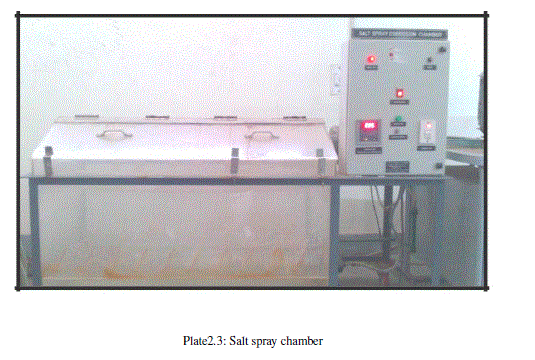 |
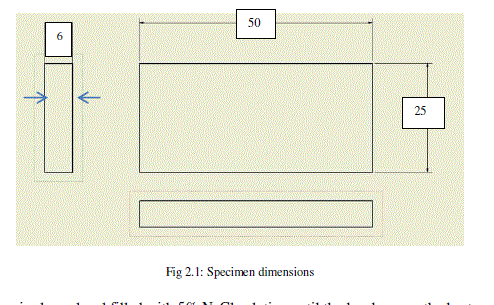 |
| The chamber is cleaned and filled with 5% NaCl solution until the level covers the heater coil in the chamber and is maintained at 35˚C.The lid of the chamber is closed and made sure it is air tight. The compressor is also switched on to help the uniform distribution of fumes. The specimens are removed after every 3 hours and are cleaned in 70% conc. Nitric acid. The final weights of the specimens are taken and the readings are tabulated. The test is continued for 30 hrs. |
III RESULTS AND DISCUSSION |
| A. Effect of age hardening on microstructure: |
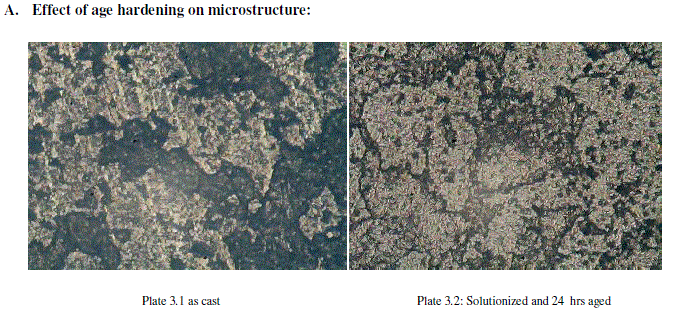 |
| Discussion on results: The microstructure of as cast specimen (plate3.1) consists of α-Al + Eutectic phase (dark) in α - Al matrix (light) and the eutectic phase is present at the grain boundaries. The solutionized and peak age hardened microstructure (plate3.2) consists of fine precipitates homogeneously distributed second phase elements in the aluminum matrix. The distribution of Precipitates is uniform in age hardened condition. The precipitates are mainly non coherent η-phase. |
| B. Effect of Retrogression and Reaging on microstructure: |
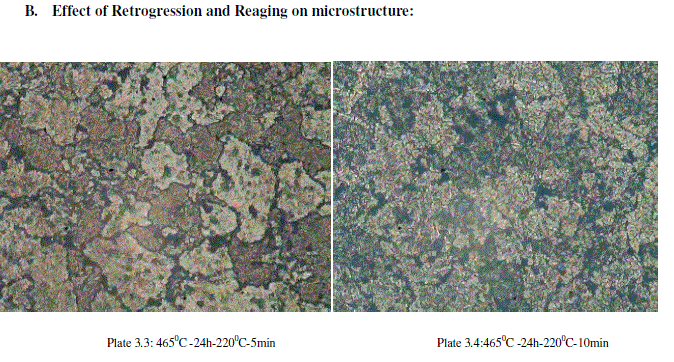 |
| Discussion on results: From plate 3.3 and 3.4, it can be observed that Retrogation time increased the dissolution of non coherent η-phase and increased the precipitation of coherent η1-phase This could be the reason for increase in hardness of the material with RRA treatment than pre-aging treatment initially. But further increase in Retrogation time incresed grain coarsening and decreased hardness. |
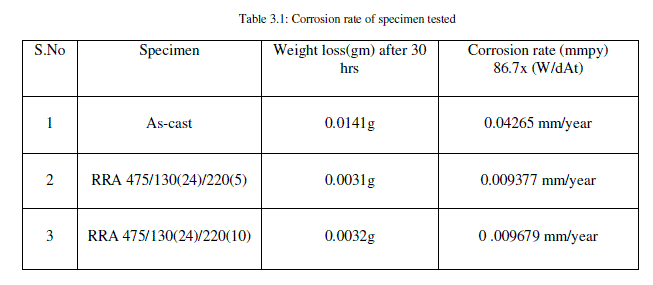 |
Effect of retrogression and reaging on weight loss due to corrosion |
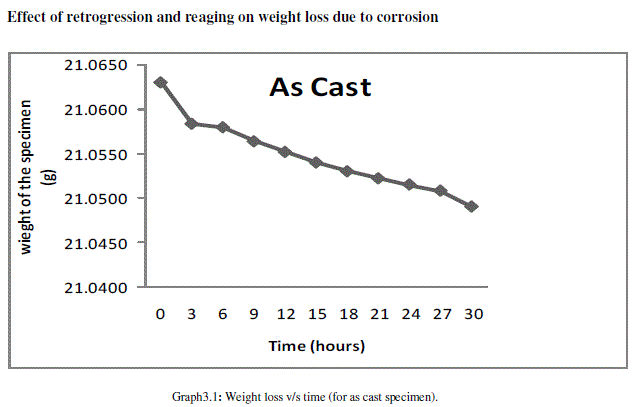 |
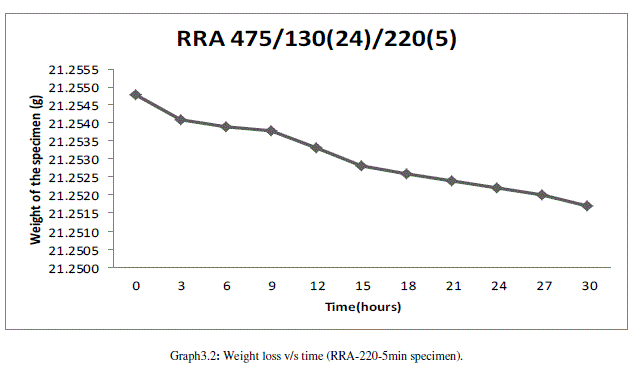 |
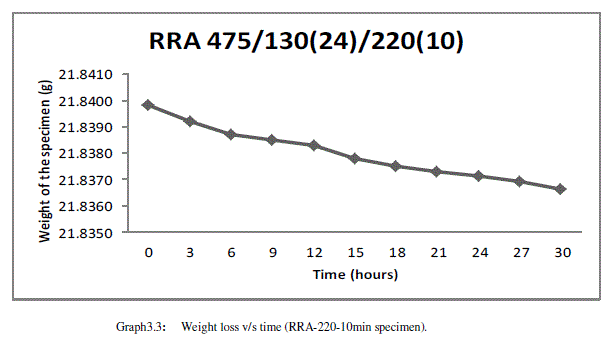 |
| Discussion on resultsTheslope for as-cast specimen is greater when compared to the others, which implies that the weight lost by the as-cast specimen is more, showing the maximum corrosion rate than the RRA treated specimen.RRA treatment increased the corrosion resistance of the material. The decrease in corrosion loss is 78.01% for the 5 min retrogressed specimen and it is 77.31% for the 10 min retrogressed specimen. The reason could be size and amount of precipitates at the grain boundary and also within the grains. The fine precicitates due to RRA treatment would have decreased the decrease in weight loss due to corrosion and hence corrosion rate. |
IV. CONCLUSIONS |
| The microstructure of as cast specimen consists of α-Al +Eutectic phase (dark), in α -Al matrix (light) and the eutectic phase is present at the grain boundaries. |
| The solutionized and age hardened microstructure consists of precipitates homogeneously distributed second phase elements in the aluminum matrix. |
| Re-precipitation of the matrix takes place during Retrogression and reaging treatment, and this has coarsened the grain boundary precipitates. Retrogression treatment has dissolved the less stable precipitates, allowing it to grow as more stable grain boundary precipitates. Thus, reaging enhances the re-precipitation of η1-phase. This could be the reason for improvement in properties of T6 temper. |
| Similarly RRA treatment increasesthe corrosion resistance of the material.The decrease in weight loss due to corrosion is 78.01% for the 5 min retrogressed specimen and it is 77.31% for the 10 min retrogressed specimen when compared with as cast specimen. The reason could be the size and the amount of precipitates at the grain boundary and also within the grains . The fine precicitates due to RRA treatment would have decreased the corrosion rate. |
| The RRA treated specimen have shown excellent relative corrosion resistance than the as cast specimen. |
ACKOWLEDGEMENT |
| We thank the management of MSRIT and Dr S.Y.Kulkarni, principal, MSRIT,Bangalore,India for motivating and providing Research facilities for carryingout this research. |
References |
|